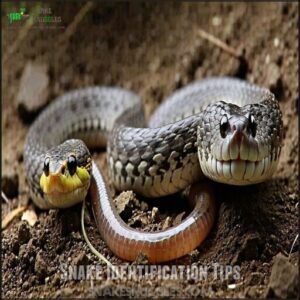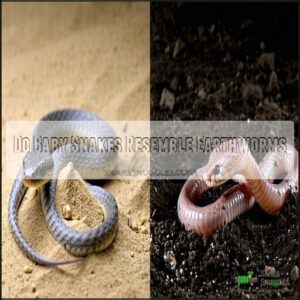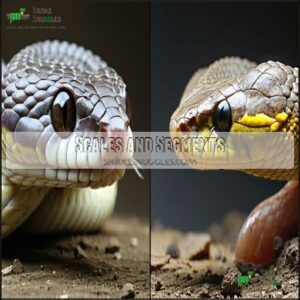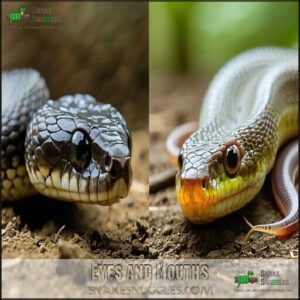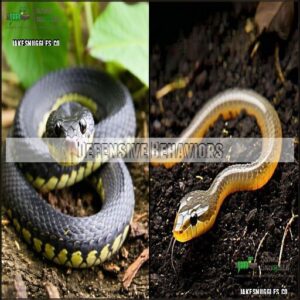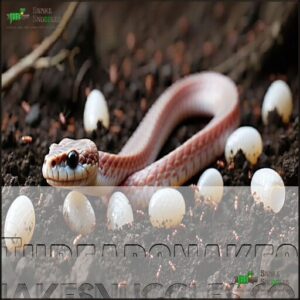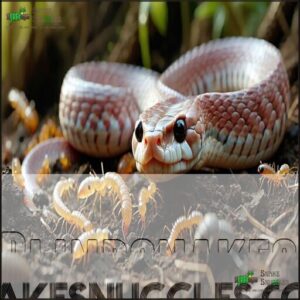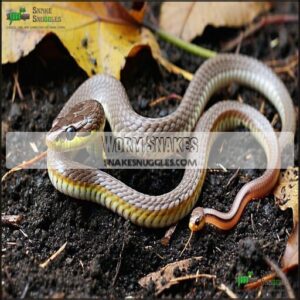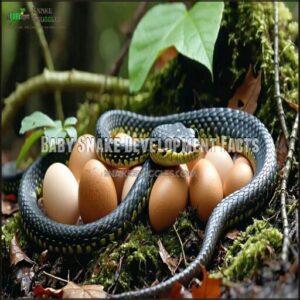This site is supported by our readers. We may earn a commission, at no cost to you, if you purchase through links.
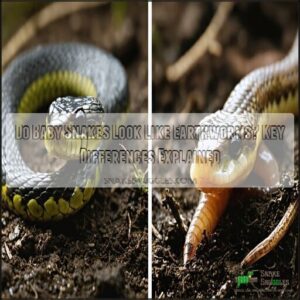
Unlike an earthworm’s smooth, segmented body, baby snakes are covered in delicate scales that shimmer in the light.
They also have tiny, visible heads with eyes and a mouth—features worms completely lack.
Movement is another giveaway: snakes slither with purpose, while worms wriggle in a sort of accidental dance.
Some species, like threadsnakes or blindsnakes, do resemble worms more closely, but even these have snake-like traits.
So, while they might fool you for a second, baby snakes have their own slippery charm.
Curious? Let’s explore!
Table Of Contents
- Key Takeaways
- Snake Identification Tips
- Do Baby Snakes Resemble Earthworms
- Distinguishing Features
- Snake Species Mistaken for Worms
- Baby Snake Development Facts
- Frequently Asked Questions (FAQs)
- What does a baby snake look like?
- Do baby snakes look like earthworms?
- What is the difference between Worms and Baby Snakes?
- Do snakes look like worms?
- Can a baby snake be mistaken for an earthworm?
- What is the difference between a worm and a snake?
- How to tell the difference between an earthworm and a baby snake?
- What baby snakes look like worms?
- What kind of snake looks like an earthworm?
- Are snakes mistaken for worms?
- Conclusion
Key Takeaways
- Baby snakes may look like earthworms because of their small size and shiny bodies, but their scales, defined heads, and tiny eyes set them apart.
- Unlike worms, which have segmented bodies and random movements, baby snakes slither purposefully and have a more polished appearance.
- Species like threadsnakes and blindsnakes look worm-like but have snake-specific traits like distinct tails, pointy heads, and smooth scales.
- Earthworms don’t have eyes, mouths, or scales, while baby snakes rely on these features for movement, feeding, and predator defense.
Snake Identification Tips
You can tell a baby snake from an earthworm by focusing on key features like head shape, scales, and movement.
Look closer—distinct heads, shiny scales, and purposeful slithers reveal baby snakes are no mere earthworms.
Don’t let their similar size fool you—baby snakes are more coordinated and have visible eyes and mouths, which are complete concepts that distinguish them.
Physical Characteristics
When spotting baby snakes, notice their distinct features.
While earthworm lookalikes, their scale texture gives away their identity—smooth, shiny, and polished versus soft and segmented.
Snake appearance often includes subtle coloration patterns, like gray or brown with pinkish bellies.
Their head shape is pointed, unlike an earthworm’s simple front end, and tail morphology is sharper.
Size comparison helps too—baby snakes range from 4 to 13 inches.
Accurate identification relies on snake scale features, which is crucial for accurate and reliable identification.
Body Structure
Baby snakes and earthworm lookalikes may seem similar, but their anatomy tells a different story.
Look closer—baby snakes’ scales and defined anatomy reveal their identity, setting them apart from earthworms’ segmented simplicity.
A snake’s skeletal structure gives it a defined head shape and sturdy tail morphology, unlike the uniform bodies of worms.
Snake scales also create distinct patterns on their skin, while worms lack such texture.
Plus, snakes’ internal organs are complex, highlighting key differences in their snake anatomy and appearance.
Movement Patterns
Snake movement is quite the spectacle compared to worm behavior.
Worms use simple linear writhing, but snakes showcase impressive locomotion types.
Here’s how they differ:
- Surface Movement: Snakes slither purposefully; worms wriggle randomly.
- Burrowing Mechanics: Snakes push with scales; worms contract.
- Speed Comparison: Snakes win the race every time.
- Predatory Movement: Sneaky snakes strike; worms… don’t.
Do Baby Snakes Resemble Earthworms
At a glance, baby snakes and earthworms can seem like twins separated at birth, but look closer.
Baby snakes have distinct heads, even if tiny, while earthworms are headless wonders with uniform bodies.
Size comparisons help too—most baby snakes, like wormlike snakes such as blindsnakes, measure 4–6 inches, whereas earthworms vary but lack the pointed, triangular heads of baby snakes.
Color variations are another clue.
Baby snakes often have shiny bodies with gray or black shades, sometimes featuring pink underbellies.
Earthworms are more uniform in tone, typically a dull pink or beige.
Habitat differences also play a role; baby snakes prefer sandy soils, while worms thrive in moisture-rich spots.
Movement analysis?
Snakes slither purposefully; worms just wiggle aimlessly!
These snakes often possess smooth, shiny scales that add to their worm-like appearance.
Distinguishing Features
You might mistake a baby snake for an earthworm at first glance, but a closer look reveals key differences.
From shiny scales to tiny eyes and distinct movements, these traits make baby snakes stand out in ways earthworms simply don’t, with distinct movements being particularly notable.
Scales and Segments
Baby snakes and earthworms may look alike, but their scale texture sets them apart.
While earthworms have a smooth, segmented appearance aiding movement through soil, baby snakes display overlapping scales.
This scale count helps them slither efficiently, and for those interested, you can even find products for them.
Wormlike snakes might confuse you initially, but their lack of defined scales compared to true snakes highlights their distinct segmented structure, so Look closely at the overlapping scales.
Eyes and Mouths
Next up in snake anatomy is their tiny eyes and mouths, which differ wildly from worms.
Baby snakes have dark eye spots sensitive to light, while earthworms don’t even have eyes.
Their mouths, though small, aid in feeding mechanisms like swallowing prey.
Worms rely on simpler methods, skipping bites entirely.
Snake identification just got easier!
- Eye Functionality: Sensitive to light.
- Mouth Size: Small yet capable.
- Sensory Perception: Detects surroundings actively.
- Feeding Mechanisms: Built for swallowing prey.
Defensive Behaviors
You’d be amazed at the defensive tricks baby snakes pull off. Innate strikes, tail shaking, and body inflation make predators think twice.
Unlike earthworms that wriggle aimlessly, snakes mean business. Some species even use chemical defenses to coat themselves in foul-smelling substances.
Camouflage helps snakes blend into their environment. Predator evasion is instinctive, setting these snake lookalikes apart from earthworm simplicity.
| Behavior | Baby Snakes | Earthworms |
|---|---|---|
| Striking Ability | Present | Absent |
| Tail Movements | Deliberate Shaking | Random Thrashing |
| Inflation Tactics | Inflates Body | None |
| Chemical Defense | Yes | Mucous Secretion |
| Predator Awareness | Intentional | Reflexive |
Snake Species Mistaken for Worms
You might mistake certain snake species, like threadsnakes or blindsnakes, for worms at first glance because of their small, shiny, and slender bodies.
Unlike earthworms, though, these snakes have subtle features like tiny eyes, pointed heads, and smooth scales that make them unique.
Threadsnakes
Threadsnakes, like the Texas blind snake (Rena dulcis), are often mistaken for earthworms due to their smooth, shiny bodies and small size.
They thrive in loose soils (Threadsnake Habitat) and feed on ant larvae (Threadsnake Diet).
Some may even consider purchasing related merchandise online.
Fascinatingly, these tiny snakes:
- Lay eggs communally (Threadsnake Reproduction).
- Fend off predators with secretions (Threadsnake Predators).
- Play key roles in soil ecosystems (Threadsnake Conservation).
Blindsnakes
Blindsnakes, like the Texas blind snake (Leptotyphlops dulcis), are small fossorial creatures often confused with earthworms.
Their smooth, glossy scales and pale pink or gray color make them stand out.
Found in loose soil, Blindsnake habitats support their diet of ant and termite larvae.
Their role includes controlling termite populations, which benefits the ecosystem.
Despite the name, their tiny eyes can detect light changes, aiding their burrowing behavior and helping them navigate through the soil to find termite larvae.
Worm Snakes
Worm snakes, often mistaken for earthworms, are small, wormlike snakes with smooth, shiny scales.
These fossorial creatures thrive in moist, well-drained soils, favoring eastern U.S. forests.
Their diet specifics include earthworms and insect larvae.
Unlike earthworms, they’ve tiny eyes and a blunt, pointed tail.
While blind snakes like the Texas blind snake share similarities, worm snakes’ subtle distinctions stand out.
Baby Snake Development Facts
Baby snakes go through fascinating changes as they grow, starting with their development inside soft, leathery eggs.
From hatching with an “egg tooth” to shedding their skin as they mature, their growth is efficient and perfectly suited for survival.
Embryonic Development
Starting as a tiny zygote, snake embryos grow inside soft, leathery eggs, relying on the egg yolk for nutrition.
The embryos undergo detailed neural development during their gestation period, forming organs and systems.
This precise egg development guarantees the hatching process produces viable, active snakes, and embryo growth within the egg showcases nature’s precise design, making each snake’s birth a small, scaly miracle.
The process as a whole highlights the intricate and precise development that occurs within the egg, ultimately leading to the birth of a viable snake.
Larval Emergence
When snakes hatch, their development distinctly differs from worm larvae emerging from cocoons.
Unlike worms, snakes undergo a hatching process, using an “egg tooth” to crack their eggs.
Early survival involves seeking food, while larvae focus on consuming larval nutrition in soil.
Baby snakes instinctively burrow for safety, showing independence not seen in earthworms or other worm species, which involves a unique behavior of seeking safety.
Growth and Molting
Growth in baby snakes differs from worm development since they periodically shed their skin to accommodate their size.
This molting process, driven by their growth rate, replaces old, worn skin with new layers.
Unlike worms, whose larvae development involves molting tiny segments, snake development yields a sleeker look post-shedding.
Like many reptiles, snakes are cold blooded creatures and rely on external temperatures.
Think of it as nature’s way of upgrading their wardrobe, which is a result of being cold blooded and undergoing a process of molting to achieve a new look.
Frequently Asked Questions (FAQs)
What does a baby snake look like?
Imagine spotting a shiny, tiny creature wiggling in the dirt—a baby snake might fool you.
With smooth scales, a triangular-shaped head, and pink or gray colors, it’s often mistaken for an earthworm.
Do baby snakes look like earthworms?
Baby snakes can look like earthworms at first glance due to their tiny size, shiny bodies, and similar colors.
However, snakes have distinct heads, tiny eyes, and smooth scales, unlike an earthworm’s segmented, uniform body.
What is the difference between Worms and Baby Snakes?
It’s like comparing a pencil to a paintbrush—worms are smooth and uniform, while baby snakes have defined heads, scaly bodies, and unique movement.
Snakes may flick tails defensively; worms just wiggle instinctively, which can be a key difference to identify when distinguishing between the two.
Do snakes look like worms?
Snakes and worms might seem alike at first glance, especially tiny snakes with smooth, shiny scales and no clear neck.
But look closer—snakes have distinct heads and movement, unlike the segmented, wiggling bodies of worms.
Can a baby snake be mistaken for an earthworm?
Holding a tiny snake, you might swear it’s just a shiny, misplaced earthworm.
But look closer—those triangular heads, tiny eyes, and wriggling motion give them away.
Baby snakes often confuse, but they’re unmistakably unique!
What is the difference between a worm and a snake?
A snake’s pointed head, scales, and coordinated motion set it apart from a worm’s soft, segmented body and wriggling.
Snakes eat prey, while worms feast on decaying matter—two creatures with totally different "dining" habits!
How to tell the difference between an earthworm and a baby snake?
Spot the difference: look for tiny eyes and a defined head on baby snakes, unlike earthworms’ uniform shape.
Baby snakes move intentionally with winding motions, while earthworms writhe in simple, repetitive patterns.
What baby snakes look like worms?
Some baby snakes, like Brahminy blindsnakes and Texas blind snakes, closely resemble worms due to their small size, shiny bodies, and muted colors.
However, their pointed heads and distinct tails help set them apart.
What kind of snake looks like an earthworm?
Did you know some tiny snakes, like the Brahminy Blindsnake, are just 4-6 inches long and shiny enough to fool you into thinking they’re earthworms?
Their smooth bodies and worm-like wiggling often cause confusion!
Are snakes mistaken for worms?
It’s pretty common to confuse tiny snakes with worms, especially since some, like the Brahminy Blindsnake, are shiny, thin, and wiggly.
But snakes have heads, scales, and purposeful movement—traits worms don’t share!
Conclusion
Imagine this scenario: you’re glancing down, and what looks like an old-fashioned earthworm wiggles by—except it’s smoother, shinier, and moving with intent.
That’s likely a baby snake, not a worm! Baby snakes have scales, tiny visible heads with eyes, and a unique slithering motion that worms simply can’t mimic.
Even species like threadsnakes or blindsnakes, which resemble worms, have undeniable snake-like traits. So, while baby snakes might fool you at first, recognizing these key differences makes it easy!
- https://www.floridamuseum.ufl.edu/florida-snake-id/snake/brahminy-blindsnake/
- https://tpwmagazine.com/archive/2018/nov/scout5_wildthing_snake/
- https://portal.ct.gov/DEEP/Wildlife/Fact-Sheets/Eastern-Wormsnake
- https://www.facebook.com/UPwild/videos/a-blind-snake-that-looks-like-a-worm/260065574876695/
- https://www.natureblog.org/worm-or-snake/

